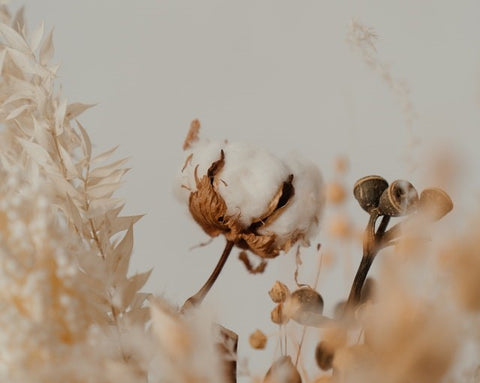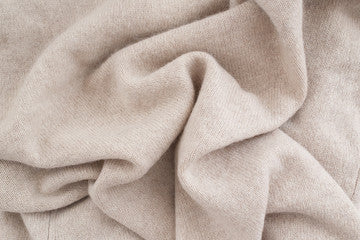Following on from our article on sustainable and eco-responsible materials, we're going to take a look at conventional materials. Beware, we're about to tackle some heavy stuff, so fasten your seatbelts and sensitive souls please refrain.
First of all, if you're wondering what a conventional material is, don't worry, we've written an article that explains it all!
The fibers that make up these materials are transformed into usable textiles using chemicals that degrade nature and are often widespread.
There, now that that's clear, we can go.
Materials Plant-based materials
We're off to a great start with conventional cotton.
Cotton is currently the most widely used plant-based material in the textile and clothing industry. If most companies use cotton, why is it so harmful?
That's simply because it's cheaper in terms of manufacturing cost and purchase price.
This fiber, unlike organic cotton, requires enormous quantities of water for its cultivation and processing. The fertilizers, pesticides, insecticides and GMOs used to make the fiber healthy and exploitable degrade the soil and retain water.
This prevents cotton from developing and growing properly. This is why a lot of water is needed for its cultivation. Soils are stripped and even become infertile after a while.
The chemicals and heavy metals used during bleaching and dyeing are highly polluting and toxic. Because of these chemicals, 1 million people develop cancer, skin and organ diseases.
We prefer organic cotton, which is more sustainable and eco-responsible.

Materials of animal origin
Then, among the conventional materials of animal origin, we find wool. This fiber comes from sheep and is recovered by shearing them without really respecting them. The practice of mulesing is often used. This process consists of cutting off the genitals and the surrounding strips of skin on the animal's hindquarters.
Unfortunately, mulesing is widely practised as a means of avoiding fly infections. Breeding conditions can be shocking and can be qualified as animal abuse.
As the name suggests, during the transformation stage, the fiber undergoes a number of changes. These changes require the use of chemicals such as sodium hypochlorite and sulfuric acid . The former is used to bleach the wool, while the latter removes any impurities.
These products are therefore toxic and can damage human skin and organs. Like cotton, organic and mulesing-free wool is a more respectful alternative.

Still on the subject of materials of animal origin, let's talk about cashmere!
Yes, this soft, comfortable fiber has many advantages... It comes from Mongolian goats. As with sheep's wool, goat breeding is intensive and almost all are castrated (not really shocking, it's the BA ba) and gored.
You might ask what dehorning is! Well, it's cutting off an animal's horns. Most often when the animal is just a few days old, so that its horns don't get caught in fences.
This practice can be painful for the animal, even if carried out under anaesthetic.
What's more, as they graze, the goats pull out the roots of the grass, thus contributing to the desertification of the land.
In some cases, the animals are killed in order to tan the skin with the wool intact.

Materials of synthetic and artificial origin
Now let's move on to conventional materials, known as artificial or synthetic. Before we start, it's important to know what we're talking about. Artificial fibers are actually produced from natural resources, or from corn and soy derivatives. These resources are then transformed by a chemical process, which is not natural, and is highly polluting and toxic.
One of the most widespread artificial materials is viscose.
The first step is to extract the plant cellulose from the fiber, using a mixture of sodium sulfate and citric acid. These are highly toxic and chemical agents. Plant cellulose is a carbohydrate made up of a chain of molecules, and is the main constituent of plant cell walls. It is from this cellulose that we can recreate the vegetable fiber of a natural resource.
But the process doesn't stop there. This liquid mixture must then be transformed into a vegetable paste using carbon disulphide. This toxic product is also volatile, and causes considerable air pollution.
To obtain 400 g of viscose, you need 1 kg of plant fiber. The quantity of water and vegetable plantations is therefore considerable for a small quantity obtained.

After viscose comes acrylic.
What is acrylic? Acrylic is a synthetic, chemical fiber obtained from mineral or hydrocarbon oil. Basically, it's a petroleum derivative... Not great.
Acrylic doesn't have a long lifespan and soon ends up in the garbage can. This material contributes to waste and pollution. It also releases small particles of plastic.
Once in the washing machine, the particles detach themselves from the garment, go into the sewage treatment plant and then into the wastewater. Finally, they are released back into nature. Acrylic thus pollutes the seas and oceans and damages aquatic ecosystems.
What's more, this textile fiber is carcinogenic for the workers who transform it and for those who wear it. The risk of allergies andirritations is high, and some even consider it an endocrine disrupter.

As you'll have gathered by now, conventional materials are not always environmentally friendly, and cause significant damage to our planet.
So, of course, there are other conventional materials, but we've seen the ones most commonly used in the clothing industry.
Fortunately, there are materials today that are more respectful of nature and human well-being. In fact, more and more brands are turning to this alternative for ethical fashion, which is a good thing!
To find out more about organic cotton, we have also written a great article detailing the price of organic cotton:
HIGHER PRICES FOR ORGANIC COTTON AND RAW MATERIALS
"Mind you, we're not telling you to throw away all your clothes. Because you won't be able to wear much...
But reading labels and knowing what components are present is a great step forward, and we congratulate you!"
If you'd like to add one [or more] MaisonFT organic cotton tee-shirts for men to your wardrobe, that's possible too!
Louise, Editor

Leave a comment